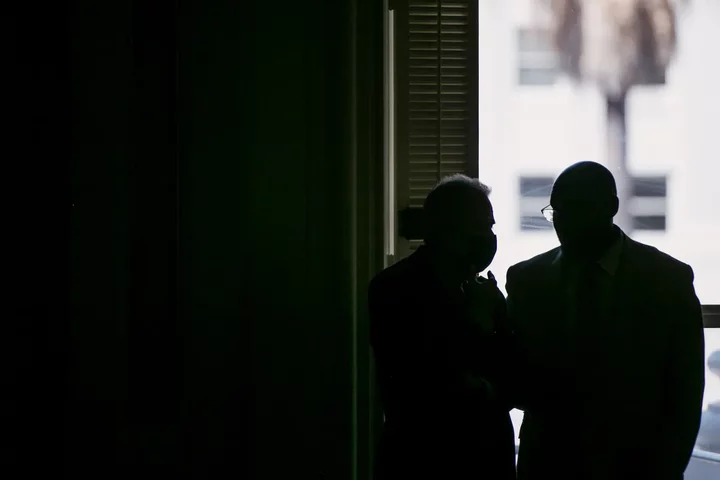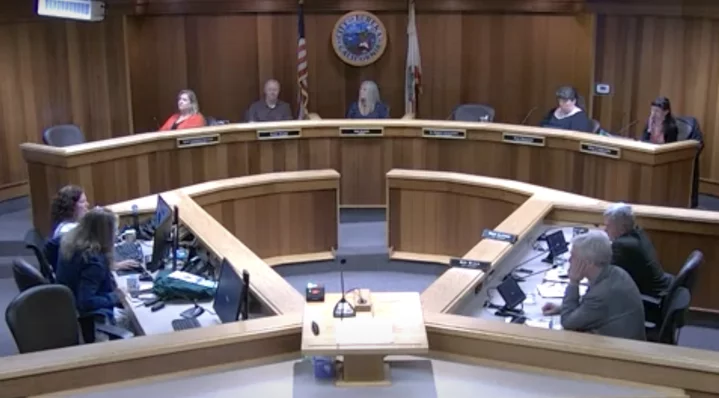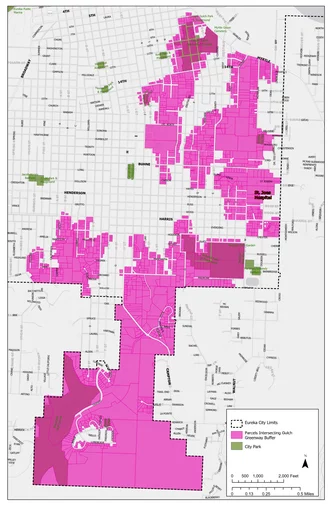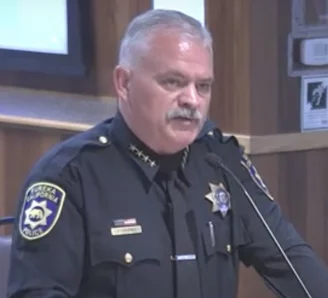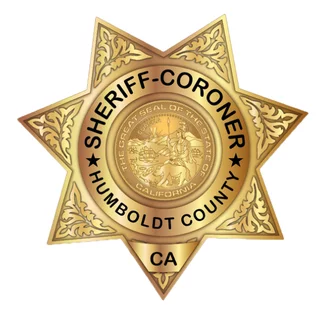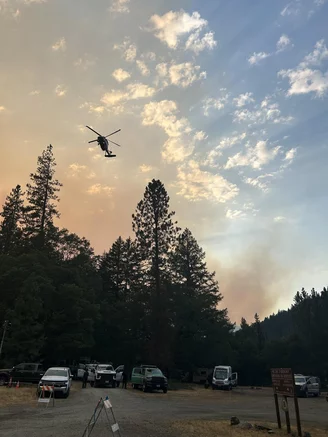Citing Security Threats, California Lawmakers Want to Shield Their Addresses From Public
Yue Stella Yu / Yesterday @ 7 a.m. / Sacramento
Legislators convene during a session at the state Capitol in Sacramento, on Aug. 22, 2022. Photo by Rahul Lal, CalMatters
###
This story was originally published by CalMatters. Sign up for their newsletters.
###
California lawmakers want to limit public access to their addresses and phone numbers after two Minnesota lawmakers were shot, one fatally, in their homes last month.
One proposal would ban journalists from accessing that information through candidates’ and public officials’ voter registration records, even though there is no indication the Minnesota shooter used those kinds of records to track down his victims.
Officials’ voter registration data is already confidential to most of the public. It is available to a select few, including journalists. But AB 1392, authored by Assemblymember LaShae Sharp-Collins of La Mesa and sponsored by Secretary of State Shirley Weber’s office, would eliminate that carve-out and effectively block journalists’ access to politicians’ phone numbers, emails and home addresses and prior voter registration.
“This common-sense bill will protect public servants and their families,” Sharp-Collins told lawmakers during a Tuesday Senate hearing.
Stripping the public of vital information?
But press freedom advocates say they doubt the measure would protect public officials from violence, arguing it would instead strip journalists of vital information they use to keep government officials in check. Journalists often use a politician’s residential address to determine if they live in the district they represent and are eligible for office.
“Democracy is founded on the promise of ‘trust but verify.’ We are not required to take the government’s word for it,” said David Loy, legal director of the First Amendment Coalition, which advocates for public access to government documents and proceedings. “We understand the concerns, but this should not deprive the press of its ability to do fundamental watchdog and accountability reporting.
Sharp-Collins’ chief of staff Michael Lucien said she did not have time for an interview. Her office also did not respond to questions sent by CalMatters via text about how her measure would protect public officials, or whether she believed anyone had used information obtained from their voter registration to target them.
State lawmakers have often cited security concerns in passing laws that limit public disclosure. Last year, they made it harder to access politicians’ phone numbers, home addresses and records about properties they own, all of which they are required to disclose in their economic interest statements. A 2022 law allowed California government workers and contractors to shield their addresses from the public if they fear violence.
This year, as lawmakers pushed to reduce public access, they cited fear of violence when they sought to shield use-of-force reports by peace officers and to restrict data brokers from selling politicians’ personal information.
“Every single year, we see a number of attempts to limit the public’s access to information and access to their lawmakers in person,” said Brittney Barsotti, general counsel of the California News Publishers Association. “(AB 1392) is just another attempt that is concerning.”
Timothy Cromartie, representing Weber’s office, said at a Senate Elections and Constitutional Amendment Committee hearing earlier this month that “escalating threats” to public officials make the measure “an urgent necessity.” He pointed to the slaying of Minnesota state Rep. Melissa Hortman and her husband last month, the arson on Pennsylvania Gov. Josh Shapiro’s home in April, the assassination attempt on President Donald Trump last year and the 2022 hammer attack on former U.S. House Speaker Nancy Pelosi’s husband at their home.
An earlier version of the measure only applied to state and federal officials. But at the suggestion of the Senate elections committee, it was expanded to apply to local elected officials and candidates for office and allow the secretary of state’s office to make the information private sooner.
But critics doubt the proposal would help prevent tragedies like the Minnesota shootings, where the alleged suspect appeared to have obtained the lawmakers’ home addresses via “people search” sites instead of the voter roll.
They argue that state law lays out a rigorous request process, where those qualified to receive the voter registration information must submit their names and contact information, explain the reason for their request and attest to their honesty under penalty of perjury.
“It seems highly unlikely at best that reporters or others able to take advantage of that carve out under those strict conditions are going to commit crimes with that information,” Loy said.
Loy said the information not only helps journalists fact check officials’ residency claims, but also allows reporters to identify politicians if they did things such as receiving a home as a gift from special interests, or leasing to or renting property from their major donors.
A check on data brokers
Another proposal inspired by the Minnesota tragedy, AB302 by Assemblymember Rebecca Bauer-Kahan of San Ramon, sought to allow politicians to request businesses, including data brokers and media outlets, to take down or refrain from publishing their personal information, opening the organizations up to lawsuits and fines if they do not comply.
An earlier version of the measure risked violating the First Amendment since it could chill and censor legitimate speech, according to a Senate Judiciary Committee analysis. The First Amendment Coalition and the Freedom of the Press Foundation opposed the effort, citing similar concerns, adding that newsrooms could be exposed to frivolous lawsuits simply because politicians do not like stories they publish.
“These demands and lawsuits will chill news outlets from reporting on matters of public concern,” the groups said in a joint letter. “The fact that news outlets will have to defend their reporting as relating to a matter of public concern, potentially through multiple appeals, will cause some to self-censor.”
Bauer-Kahan told CalMatters Monday that her intention was to discourage data brokers from selling politicians’ personal information. She has agreed to amend the measure to instead require the California Privacy Protection Agency to compile a list of politicians and request data brokers to delete their personal information.
“That’s not nearly as troubling as giving them … a tool to be weaponized to silence legitimate reporting,” Loy said.
BOOKED
Today: 15 felonies, 9 misdemeanors, 0 infractions
JUDGED
Humboldt County Superior Court Calendar: Today
CHP REPORTS
Us101 (HM office): Traffic Hazard
10040 Mm101 S Hum 100.40 (HM office): Trfc Collision-Unkn Inj
Us101 N / Pepperwood Ofr (HM office): Trfc Collision-1141 Enrt
ELSEWHERE
RHBB: Major Injury Crash on State Route 20 Stops Traffic in Both Directions
RHBB: Butler Fire Surges Across Salmon River, Threatens Forks of Salmon
RHBB: Coast Guard Provides Details on Rescue of 11-Year-Old Girl from Surf at Big Lagoon
OBITUARY: Mark Allen Williams, 1946-2025
LoCO Staff / Yesterday @ 6:56 a.m. / Obits
Mark Allen Williams
December 25, 1946 – July 2, 2025
With great sadness, we announce that Mark Allen Williams passed away peacefully at home on July 2, 2025, just where he wanted to be. He was surrounded by love — his wife Nancy holding his hand, Adriana from Hospice, Chris from Agape Home Care, and his beloved cat Abby curled beside him.
Mark was born on December 25, 1946 — a Christmas baby — at Sacred Heart Hospital in Eugene, Oregon, to Marie and Eldon Williams. In 1959, the family moved to California where Mark grew up on Humboldt Hill alongside his brother and sister. He graduated from Eureka High School, Class of ’66, and soon after enlisted in the U.S. Army, serving from 1966 to 1972.
Mark loved the outdoors. Hunting and fishing were his lifelong passions. He spent countless trips at Shasta Lake, Ruth Lake, and even Sonoma. He especially cherished duck hunting on the South Bay, particularly trips to Teal Island with his loyal hunting buddies — including his brother Kelly, Jim Patton, Jack Jansen, and Larry Tostie. Rain or wind never stopped them. They camped out the night before opening day, sharing food, stories, and laughs around the fire.
Mark worked at the Eureka Fishery before joining the pulp mills, where he remained until their closure in 2008. He had a strong work ethic, a sharp wit, and a warm laugh that left lasting impressions on all who knew him.
For years, Mark was single, waiting for something — or someone — special. Then he met Nancy (Sallady Lower) on a blind coffee date. That very night, he told his coworkers, “I’m going to marry that country girl.” He was right. They were married on April 17, 2004, in a beautiful local ceremony surrounded by family and friends.
Mark embraced Nancy’s children as his own:
- Bill (Kathryn) Lower, and granddaughters Ava and Emily
- Lt. Col. Craig (Theresa) Lower
- Jennifer Lower
His heart was full. Becoming a stepfather and grandfather was one of the greatest joys of his life. Mark is also survived by his children from his first marriage:
- Michael Williams
- Heather (Kevin) Pope, and four grandchildren
He is survived by his loving wife Nancy of 21 years, his brother Kelly (Teresa) Williams, and sister-in-laws Colleen Farley and Gloria Dowd, along with many nieces, nephews, great-nieces and -nephews, and great-greats as well.
He was preceded in death by his parents Marie and Eldon Williams, sister Lisa Miller, and nephew Justin Miller.
In 2005, Mark and Nancy traveled to Hawaii for the wedding of stepson Craig, who was stationed there at the time. Mark was like a fish out of water—but quickly adjusted to wearing t- shirts, shorts, and leaving the camo at home. He even got a fake tattoo! It turned out to be a great trip with beautiful memories. Mark joked afterward, “once is enough,” and laughed that there was no place to go hunting.
Mark and his brother Kelly shared many years of hunting, fishing, and brotherly adventures— especially their annual trips to Ruth Lake. They packed like they were supplying an army and had the best time together. As Mark’s health declined, those trips became cherished memories.
Mark taught Nancy to hunt and fish, although ocean fishing turned out to be a one-time adventure (small boat, big waves, and Nancy can’t swim!). They shared many laughs, including one unforgettable trip where their dogs tipped the boat trying to sit next to Mark — chaos and joy wrapped into one hilarious memory.In recent years, Mark bravely battled dementia. He worried Nancy would leave, but she never did. She stayed by his side with unshakable love and commitment — through every moment, every challenge.
A special thank you to the VA Clinic in Eureka, especially Dr. Cutler, for her incredible support. We are deeply grateful to Hospice of Humboldt and Agape Home Care for their outstanding compassion and care. Mark lit up when his caregivers arrived, especially his nurse Sara and nurse’s aid Adriana. He kept them laughing, even in his final days. Thank you to James, John, Chris, Elliott, Debbie (Hospice Social Worker), and all who became like family to us. Because of your kindness and support, we were able to honor Mark’s deepest wish—to live and pass away at home, peacefully and with dignity.
Per Mark’s request:
1. There will be no funeral or memorial service.
2. His ashes will be scattered by Nancy in the three places he lovingly chose.
3. He asked that no one be sad — just remember the good times shared with him.
Thank you to all who have offered love, support, and a helping hand to Nancy.
In Mark’s memory, and in honor of the incredible care he received, donations may be made to Hospice of Humboldt.
With love and gratitude,
Mark & Nancy Williams
###
The obituary above was submitted on behalf of Mark Williams’ loved ones. The Lost Coast Outpost runs obituaries of Humboldt County residents at no charge. See guidelines here.
COUNCIL ROUNDUP: Eureka OKs $8.2 Million for New Operations Complex; Gulch Greenway Ordinance Clears Final Hurdle
Isabella Vanderheiden / Wednesday, July 16 @ 4:56 p.m. / Local Government
Screenshot of Tuesday’s Eureka Council meeting.
###
The Eureka City Council made quick work of last night’s agenda, a welcome change after what seems like an extended run of lengthy, often contentious meetings focused on hot-button issues. While last night’s discussion largely focused on the city’s Gulch Greenway Ordinance, there was also some talk about the new Eureka Operations Complex and the latest policing statistics from the Eureka Police Department.
Let’s dig in!
Eureka Operations Complex
Following a mere 15-minute discussion, the city council unanimously approved a $8.2 million funding request for the new Eureka Operations Complex, the city’s new Public Works headquarters, maintenance facility and corporation yard. The new facility, planned for a vacant lot behind Lost Coast Brewery’s brewing facilities on Highway 101, will also serve as the city’s emergency operations center during critical incidents.
The funding allocation includes $7.6 million for the first phase of construction, which is slated to begin later this year, along with $324,000 to Scott Edwards Architecture for additional design services and $237,000 to Swinerton Builders for pre-construction services for the second and final phase of the project. If everything goes according to plan, the second phase should wrap up by the end of next year.
A digital rendering of the new Eureka Operations Complex and Public Works headquarters. | Image: Scott Edwards Architecture
Speaking at last night’s meeting, Project Manager Katie Marsolan said for years the city has been wanting to move the corp yard from its current location at 945 W. 14th Street, near Costco, to an upland site outside of the coastal zone. The city purchased the 5.6-acre site from the owners of the Ocean View Cemetery in November 2023 and quickly retained an architect and contractor to draw up plans for the new facility.
After the presentation, Councilmember Scott Bauer asked if the city had plans to incorporate solar energy into the project. That’s the end goal, but the funding isn’t quite there, Marsolan said.
“The actual positioning of our building allows us to have great exposure for solar,” she continued. “We will have some photovoltaic solar on the building, but we won’t be covering the whole building yet, until I can afford it or get a cool grant.”
Councilmember Leslie Castellano made a motion to approve the funding request, which was seconded by Bauer and approved 4-0, with Councilmember G. Mario Fernandez absent.
Image: Scott Edwards Architecture
Gulch Greenway Ordinance
After years of planning, the Gulch Greenway Ordinance received unanimous approval at last night’s meeting. The long-awaited ordinance sets new development standards and environmental protections for the “Gulch Greenway Management Area,” which includes parcels within and adjacent to Cooper Gulch, Second Gulch and the gulches of Martin Slough.
The council approved the ordinance in two separate actions. Bill No. 1044, which passed in a 3-0 vote, with Bauer recused and Fernandez absent, added a Gulch Greenway Overlay Zone to the city’s inland zoning map and additional regulations to the zoning code. Bill No. 1045, which passed 4-0, with Fernandez absent, added a few municipal code updates for tree removal, landscaping and grading.
During the public comment portion of the meeting, Eureka resident Sue Parfit asked for clarity on a piece of the ordinance that says, “vegetation removal required by the property owner’s insurance company as a condition of maintaining coverage may be approved with a Zoning Clearance.”
Following public comment, Councilmember Kati Moulton expressed similar concern, adding that she wanted to ensure that residents — especially during the purchase or transfer of a property — would have ample time to obtain insurance if they didn’t have it already. Development Services Director Cristin Kenyon said staff could easily amend the text to address Moulton’s concern.
After a bit of additional discussion, Moulton made a motion to that effect, which was seconded by Councilmember Renee Contreras-DeLoach and passed 3-0.
Discussion surrounding Bill 1045 was focused on tree hazards and who residents should contact if they have an immediate concern. Kenyon said staff could add that information to the city’s website. The bill passed in a 4-0 vote.
EPD Quarterly Report (April-June)
Ahead of next week’s quarterly meeting of the Community Oversight on Police Practices (COPP) Board, Eureka Police Chief Brian Stephens shared the latest round of department statistics with the council.
In the years following the COVID pandemic and a period of severe understaffing at EPD, Stephens said the department became “more reactive than proactive toward certain things,” which he’s been trying to change. In the last quarter, officer-initiated activity has gone up by 95 percent, Stephens said.
“Our traffic stops are up 292 percent,” he continued, noting that there’s been a 10 percent decrease in both 9-1-1 and non-emergency calls in the same time period. “[Traffic stops] play a vital role, not only in our traffic enforcement side of the house, but they also lead to multiple other types of investigations for our patrol officers to dive deep into because they’re stopping people and finding different things on those stops.”
Bike and pedestrian stops are up by 833 percent, he said. A little later in the discussion, Mayor Kim Bergel asked what people were being stopped for and whether officers were stopping children without helmets.
“Do you want us to hand out tickets to kids?” Slattery joked. Bergel, somewhat annoyed, said she was concerned about the rate of concussions among children who didn’t use helmets.
Stephens said the increased enforcement was prompted, in part, by the fatal traffic accident that took place two months ago on Harris Street.
“[After that] we did give direction to be more aggressive [in] looking at violations of the law concerning bicyclists that have to do with rules of the road,” he continued. “Folks running stop signs, stop lights, riding the wrong way — the things that are leading to some of the more horrific traffic collisions that we’re having. We’re trying to address those and make the public aware of those violations … to hopefully divert some of those accidents from actually happening.”
However, Stephens couldn’t say whether kids were being “pulled over” for not wearing helmets. “I can’t say that for sure, but I would hope that officers would address those situations … when they have time to do so,” he said.
Stephens also noted that mental health-related calls and 5150 holds are up, which he attributed to the fact that there is a full-time officer in Old Town.
“That Old Town officer allows for more direct contact in the areas where we see some of the highest concentration of our community members needing assistance,” Stephens said. “He has been working collaboratively with [Crisis Alternative Response Eureka] CARE to address some folks that need some additional attention, and trying to get them the assistance they need.”
The council thanked Stephens for the report, with a few members sharing personal gripes about people speeding on city streets, but did not take any action on the item.
###
Humboldt Deputies Destroy Over 2,000 Growing Marijuana Plants on SoHum Property
LoCO Staff / Wednesday, July 16 @ 4:46 p.m. / Cannabis
Humboldt County Sheriff’s Office release:
On July 14, 2025, deputies with the Humboldt County Sheriff’s Office Marijuana Enforcement Team (MET) served a search warrant in the area of Sunset Ridge in Blocksburg.
The warrant service stemmed from an investigation patrol deputies conducted after being alerted to an ongoing trespassing issue on the rural property. While on scene looking for the trespassing subjects, patrol deputies located two large areas actively being utilized for cultivating marijuana.
MET deputies were notified of the illicit cultivation and sought a search warrant for the property. During the service of the warrant, MET deputies located and eradicated 2,312 growing marijuana plants.
No subjects were located on the scene. This investigation is ongoing.
Anyone with information about this case or related criminal activity is encouraged to call the Humboldt County Sheriff’s Office at (707) 445-7251 or the Sheriff’s Office Crime Tip line at (707) 268-2539.
Two Arrested in Arcata in Possession of Massive Amounts of Cash, Coke, Ketamine, Shrooms and More, Says DTF
LoCO Staff / Wednesday, July 16 @ 4:05 p.m. / Crime
K9 Unit Cain and his haul | Humboldt County Drug Task Force
Humboldt County Drug Task Force release:
On July 15, 2025, Humboldt County Drug Task Force (HCDTF) agents served a search warrant on Zachary Jade Caso, 32, from Arcata. During the months of June and July, the HCDTF received information that Caso was trafficking large quantities of narcotics to and from Humboldt County for the purpose of sales.
HCDTF agents observed Caso traveling from Humboldt County to Los Angles, California. Upon Caso’s return, agents, with the assistance of the Fortuna Police Department, conducted a traffic stop on Caso as he entered Humboldt County.
Caso was detained without incident and his vehicle was searched. HCDTF K9 Cain alerted agents to the presence of narcotics inside of Caso’s vehicle. Agents searched the vehicle and located a large quantity of Ketamine and several thousand dollars in US currency.
After the search of the vehicle was complete, HCDTF agents responded to Caso’s residence, located in the 1400 block of Janes Road in Arcata. Upon HCDTF’s arrival at the residence, agents detained Tobias Uwe Schneer, 41, from Arcata. Agents searched the residence and located large quantities of several different types of illegal drugs and several thousand dollars in US currency. In total, from the search of Caso’s person, vehicle, and residence, HCDTF Agents seized:
Caso was transported to the Humboldt County Correctional Facility where he was booked on the following charges:
- $138,833 in US Currency
- 2.3 pounds of Cocaine
- 4.1 pounds of Ketamine
- 4.4 pounds of Concentrated Cannabis
- 8 pounds of Psilocybin Mushrooms
- 2.2 pounds of DMT
- 1.5 pounds of MDMA
- 119 Xanax bars
- 151 DMT vape pens
- 13.5 Suboxone pills
- 4 grams of MDA
- 1 gram of Valium
- Digital scales, packaging materials, pay/owe sheets
- Lab equipment/facilities for the manufacturing of liquid hallucinogenic substances
Shneer was transported to the Humboldt County Correctional Facility where he was booked on the following charges:
- 11379.6 HS Manufacturing a controlled substance
- 11379 HS Transportation of narcotics for the purpose of sales
- 11378 HS Possession of a controlled substance for the purpose of sales
- 1359 HS Marijuana for sales
- 11351 HS Possession of narcotics for the purpose of sales
- 11366 HS Operating/maintaining a drug house
Anyone with information related to this investigation or other narcotics-related crimes is encouraged to call the Humboldt County Drug Task Force at 707-267-9976.
- 11379.6 HS Manufacturing a controlled substance
- 11378 HS Possession of a controlled substance for the purpose of sales
- 1359 HS Marijuana for sales
- 11351 HS Possession of narcotics for the purpose of sales
- 11366 HS Operating/maintaining a drug house
Regrettably, the Rats Have Made Their Presence Felt at Mrs. Fields and Pretzelmaker in the Bayshore Mall and Those Businesses Will Have to Retrench For a Time
Hank Sims / Wednesday, July 16 @ 12:30 p.m. / Health
Google Street View image.
A new front has opened up in the war between the rats and Humboldt County food establishments, and that front is smack-dab down the middle of that one corner of the mall where you get your Mini-Dog Pretzel Bites and/or your White Chocolate Macadamia Nibblers.
This is according site inspection at the Bayshore Mall yesterday afternoon, at which health inspectors report that they have noted the unmistakable presence of the vile pests at two Mall mainstays. These have been closed until such time as humans can regain the upper hand.
The report on Mrs. Fields Cookie Store states that the inspector:
Observed rodent feces in multiple cabinets, on syrup boxes, in packaged food containers, on to-go single-use cups and to-go bags, on lidded containers of baking supplies and in storage of reusable plastic bins, as well as various locations on the floor perimeter.
The situation over at Pretzel Time #3579 (DBA Pretzel Maker) was no happier:
Observed rodent feces in areas that include the following locations: On glove boxes in back room, drink container sleeves, to-go containers and cup sleeves, cheese bags, tops of syrup boxes, in cabinets, on floors, pretzel mix overpack. Observed chewed plastic Google Street View image. on cup sleeves in front counter.
Also, Pretzelmaker was determined to have too strong of a chlorine mixture for cleaning purposes … which maybe you’d think would ameliorate matters? Guess not.
Some rats are about to die. May God have mercy on our souls.
FIRE UPDATE: More Evacuations Ordered as Butler Fire Exceeds 9,100 Acres With No Containment; Red Fire Nears 100 Percent Containment
LoCO Staff / Wednesday, July 16 @ 9:31 a.m. / Fire
###
Press release from Six Rivers National Forest:
Butler Fire: 9,191 acres; 0% containment
Red Fire: 116 acres; 95% containment
Operational Updates:
Butler Fire: Firefighters spent most of July 15 addressing the fire activity that had picked up along the southern corners of the Butler Fire the evening before. Two noticeable smoke plumes appeared over the fire throughout the day, but were the result of interior burning and didn’t pose a threat to containment lines.
In the southeast corner of the fire, three hot shot crews, supported by aerial resources, kept the fire from crossing the Salmon River around Nordheimer. Its southern advance, however, prompted additional evacuation orders from the Siskiyou County Sheriff’s Office, particularly for the town of Forks of Salmon.
Along the southwest perimeter, fire spilled over Butler Creek near Orleans Mountain. Crews were able to construct handline around it, bolstered by water drops from supporting aircraft.
Firefighters began the methodical work of searching for and extinguishing isolated heat sources along the fire’s northern perimeter around Butler Flat and portions of Salmon Creek Road. A pronounced smoke column was seen in the vicinity of Butler Flat, but it was the result of vegetation burning well within the fire’s interior. A similar column was spotted outside of Nordheimer, but again, nothing close enough to compromise the fire’s boundaries.
The southernmost edge of the fire in the upper elevations outside the Nordheimer area remained hemmed in by Nordheimer and Granite creeks. Crews began reopening roads, dozer lines, and handlines previously used in last year’s Boise Fire and the 2020 Red Salmon Fire to serve as indirect control lines.
Red Fire: Containment of the Red Fire remained at 95 percent as crews worked the remaining section of uncontained perimeter to locate and extinguish insolated hot spots.
Evacuations:
Butler Fire: Siskiyou County Sheriff’s Office expanded its evacuation orders July 15 to include FRK-1709 (Forks of Salmon), SIS-1707-B, SIS-1708, SIS-1804 and SIS-1805. They join the following zones already under an evacuation order: SIS-1703, SIS-1704 (Butler Creek, Lewis Creek, Bloomer Mine residents and Nordheimer Campground), SIS-1707-A and SIS-1803-A.
Zones SIS-1705, SIS-1710, SIS-1802, SIS-1808 and SIS-1906 are under an evacuation warning, where residents are advised to be prepared to evacuate if conditions become more threatening. The latest evacuation information can be found at https://protect.genasys.com.
Closures:
Butler Fire: The road between Butler Flat and Nordheimer Campground remains closed as rocks and burning debris continued to fall into the roadway. Nordheimer and Oak Bottom campgrounds are also closed.
Weather and Fire Behavior: Temperatures are expected to be slightly cooler today with highs in the upper 90s. Winds will mostly come out of the northwest with occasional gusts up to 20 miles an hour.
Fire Safety and Prevention:
Persistently high temperatures will keep fuels dry and increase potential fire danger. Individuals seeking relief from the heat by recreating in streams or rivers or in the forest need to be mindful of their vehicles’ condition or where they park. Roadside sparks or dried vegetation against the heated undercarriage of a vehicle could quickly result in a wildfire.
The Six Rivers and Klamath National Forests are not currently in fire restrictions. However, campfires should never be left unattended and should be dead out and cool to the touch before leaving. Remember, drown, stir, feel, REPEAT. Please report suspected wildfires by calling 911.
###
Helicopter flying over the Orleans Complex. | Photo: Abel Mattson.

